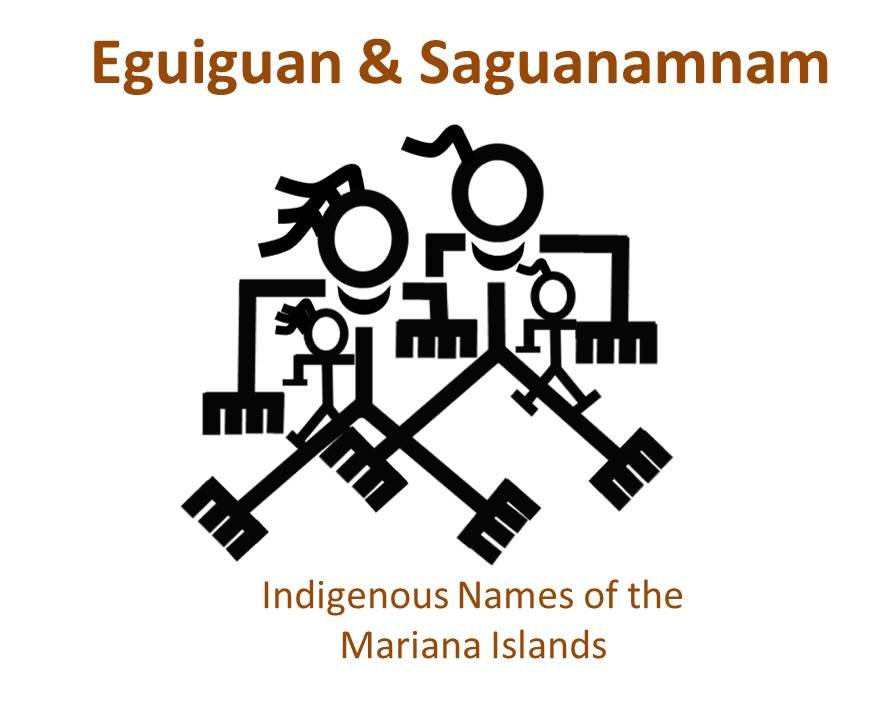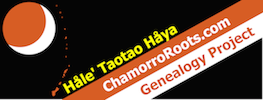
I recently received a request to elaborate on the origin of the Eguiguan and Saguanamnam surnames. I certainly appreciated the inquiry because it caused me to look deeper into a specific request with regards to indigenous names. Unfortunately, sometimes inquiries are not always easy for me to address since I am appleng and still learning to speak Chamorro more fluently. However, I try to provide a reasonable response based on my current research findings and a review of historical literature.
Every now and then I would preface my response with some of my personal observations and perspectives of history regarding indigenous Chamorro names in order to try and help frame my response. Also, because there seems to be only a hand full of people focused on Chamorro genealogy and others have convey to me that they found it of value to have some background information.
So to begin with, and depending on the discussion, there are several challenges I tend to make people aware of...
Challenges/Background Information
The first challenge is that with the Taotao Håya (the words the ancient indigenous people of the Mariana Islands described themselves as) of the mid-1600’s and earlier, only had first names. They did not have a need to have a last name like the Europeans that came from vast populations. It was not until the first full and comprehensive census in 1727, where it was apparent that indigenous people of the Marianas started to carry a first and last name. Many scholars agree that once a Chamorro was baptized, her/his indigenous name became the last name and the baptismal name became a first name. As a result, many immediate families possessed different last names, which make it a challenge (among other situations) to trace genealogical roots for our people.
Also, some scholars believe that the names of the indigenous people may have been dynamic. In other words, each individual may have had or been known by more than one name. The indigenous people of the Mariana Islands have a historical practice, to this very day, of conjuring up a variety nicknames for people they know. Some of these tend to stick and become family clan names, or, in the case of funeral announcements are “better known as” names.
For example and according to Chamorro genealogist Anthony Ramirez (1984), family nicknames tend to be derived from a reference of at least one of the following ten categories: below. For example the nickname may be a reference to:
- a first name (Kaila derived from Micaila/Duenas); or
- a surname (Robat derived from Roberts/Roberto); or
- a place name (Umåtak derived from Umatac/Garrido); or
- an animal (Kichu/Fish refers to Lizama); or
- a descriptive action or quality (Ma’fongfung/To be pounded refers to Manibusan); or
- an object (Åpu/Ashes refers to Flores); or
- a food (Chåda/Eggs refers to Cruz); or
- a status (Kabesa/Leader refers to Flores); or
- a body part (Gugat/Muscle refers to Santos); or
- some other category (Gualafun/Full moon refers to Chargualaf)
The two earliest known full Census documents from the 1700’s seem to demonstrate these examples within the indigenous names recorded.
The second challenge is the impact of conquest and colonization. The lifestyle and changes from those influences and in many cases lawful mandates may have discouraged the Chamorro people from retaining their indigenous names and identity. To some, it may have been more economically advantageous to carry a Spanish last name. Such an influence would explain, in part, the mortality of indigenous names and why few have survived over time. For instance, I personally know of a family whose original last name is Taijeron, but changed to Perez because it was easier for the US Navy personnel to pronounce and spell that latter. Conquest and colonization is also a cause and reason for why many of the indigenous words are no longer used in today’s Chamorro language. We have a lot of borrowed Spanish words in the language, and now as in my case of being appleng, incorporate a lot of borrowed English words.
The third challenge is also a result of time and space where the spelling of names may have morphed based on culture and orthography. I have observed a variety of names spelled and recorded differently in literature, census documents and other official records across time. This is somewhat the power of the pen or even of the person who physically records information such as the Census enumerators or scribes.
With those three particular challenges in mind, I will now address the two indigenous names.
Eguiguan.
I have not been successful in finding an exact match for origin or definition of this name. I do believe it is an indigenous name with a lost definition (or at least its meaning may remain in hibernation until new historical literature surfaces to revive its meaning).
The earliest recording I have found which is somewhat a similar match is the last name Egigam in the 1758 Census: Pedro Egigam married to Mariana Dungña who both resided in Miring, Rota.
In an 1823 Guam Vital Statistics Report, there was a birth recording of Jose Eguigam, July 8, 1823.
In the 1897 Census, we can find families carrying Eguiguan as a surname or recorded with their mother’s surname as their middle name.
Another potential match I found was contained in Laura Thompson’s literature (1932), where she recorded the name Eginguan as one of the “Chamorro Family Names from Guam.”
“EGINGUAN (EgIng'Guan), Accidentally-one-sided: Eging, crooked, onesided, not balanced; Guan or Guaihun,to happen to one accidentally.”
I offer a couple of other possibilities for consideration and research:
- One possibility is that the root word of Eguiguan may have been guiguan or even guigam (perhaps even two very different words), with unrecovered meanings, and were nouns. Adding the “E” changed the based word from a noun a verb.
- Another possibility is that this last name may have been erroneously recorded and may have actually been Eguihan, which means “to fish.”
Saguanamnam.
For a while, and as previously conveyed by Påle Eric Forbes (2012), the meaning of “namnam,” appeared to have been lost. Forbes further stated that “sågua” means “channel, as in an ocean inlet.” But just recently on July 12, 2015, as I was reading Volume 6 of Levesque’s History of Micronesia (1995), I found that the word “namnam” was recorded and meant “courage.”
This last name is appears twice in the 1758 Census:
- Francisco Saguanamnam, son of Estevan Taimanglo and Merenciana Manoga from Merizo, Guam
- Quintin Saguanamnam, son of Pedro Taisagui, Maria Humaña, from Agat, Guam
In an 1823 Guam Vital Statistics Report, there was a birth recording of Mariano Saguanamnam, March 15, 1823.
And, in the 1897 Census, we can find one individual with the Saguanamnam as a surname and several others recorded with their mother’s surname as their middle name.
I certainly welcome the conversation to expand the discussion on these indigenous names and their meanings. I also welcome the dialogue from those affiliated with these family names!
Bibliography
____. 1823. Guam Año de 1823. Retrieved November 9, 2015 from: http://www.guampedia.com/1823-guam-vital-statistics-report/
____. 1897. Padron de Almas: Año de 1897. Spanish Colonial Government Records, Mariana Islands 1678-1899, found in the Library of Congress, Washington, D.C.
Påle Eric Forbes. 2012a. Familia : Lujan. Retrieved November 5, 2015 from: http://paleric.blogspot.com/2012/03/familia-lujan.html
Påle Eric Forbes. 2012b. Lost Surnames : Salucnamnam. Retrieved November 5, 2015 from: http://paleric.blogspot.com/2012/08/lost-surnames-salucnamnam.html
Anthony Ramirez. 1984. Chamorro Nicknames. From Guampedia.com, accessed June 25, 2014: http://www.guampedia.com/chamorro-nicknames/
Rodrigue Levesque. 1995. History of Micronesia: Volume 6 – Revolts in the Marianas, 1673-1678. Levesque Publications: Quebec, Canada
Rodrigue Levesque. 2000. History of Micronesia: Volume 14 – Full Census of the Marianas, 1746-1773. Levesque Publications: Quebec, Canada
Laura Thompson. 1932. Archaeology in the Marianas Islands, Bulletin 100. Bernice P. Bishop Museum: Honolulu, Hawaii.

